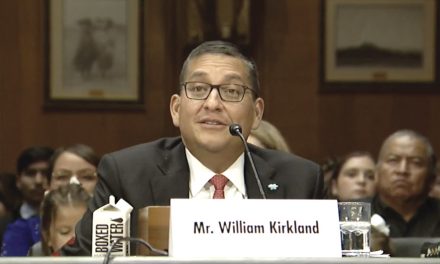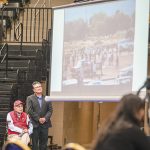
Letters: Diné College students deserve the best teachers; Ky Travis was one

I remember the first day of class in 2005 when Professor Ky Travis walked into the room and got our attention with her funny sense of humor. After we all introduced ourselves to each other, including our clans, which took a long time, one of the students asked how long she was going to be staying here at Diné College. Without any hesitation she replied, “forever.” We all laughed, forever is a very long time, but we got the point. She wasn’t going to be one of those bilagaanas who comes out here for the “Indian experience” and then leaves when the going gets rough. And it always gets rough, sooner or later.
While I was a student there I saw one president fired and then another one hired. The new one, Maggie George, had worked at the college a few years before only to leave. Now she and her husband were back and she was the next in a long line of DC presidents who apparently fell short as leaders and role models for the students.
Ky (she told us to call her Ky rather than Dr. Travis, said that titles often “exclude rather than include” others) was always a good role model for me and I believe most of her hundreds of other students. I took all of her psychology classes while I attended DC and even came back a few years later to take a few more courses so I could work on my writing skills. And so did my son’s father. Both of us went on to obtain our bachelor degrees and continued to stay in touch with her over the years.
What I also appreciated about Ky was the way she taught psychology. She always included Diné principals along with western theories. She always invited her 99.9 percent Navajo student population to share our traditional perspectives and cultural teachings. I had some Diné instructors who didn’t even do this, which is why I noticed and enjoyed her classes. She wasn’t big on lecturing either. We were all involved in creating our lessons. She called this “co-teaching” and said that she learned as much from us as we did from her. As psychology students, we learned a lot about why people do what they do, the good and the bad. All of us know that life can be hard. We all have family issues including alcohol and domestic violence. No one escapes those issues.
Ky understood that and helped us develop skills that would help us stop the problems for our own families, for my own son. What I don’t understand is why the college is now treating Ky as if she is invisible. Everyone knows that she was the one who stood up to the bullying and intimidations of the last administration. And because she did this she was immediately fired by that administration. But also because she did this, the college is now in a much better place for students. Those administrators have been fired or dismissed because of the information and facts that were first shared by Ky and later supported by an investigation. So why isn’t Ky back at the college doing what she does best? Teaching.
Once I asked her why she stayed here and today I asked her why she would want to come back after everything that she has been put through and she always says the same thing, “because I love teaching, and we have the best students!”
She is right about that, we do have the best students who deserve the best teachers. And Ky was one of them. So why hasn’t the college brought her back? The fact that they haven’t is just plain wrong!
Donna Larson
Smoke Signal, Ariz.
There must be a way to protect courageous whistleblowers
Cindy Yurth provides a hard-hitting account of the harsh realities whistleblowers face. I write this letter since I happened to have the pleasure of visiting Diné College in February 2012. I was a Fulbright Visiting Fellow at Indiana University, Bloomington, Ind., and had contacted Dr. Ky Travis, the then vice president of academics at Diné College.
I had offered to come and deliver a talk titled “Tribes, Tea and Tigers in India’s Far East”. I wanted to visit a minority college as the Council for International Exchange of Scholars offered me a travel grant to cover the visit. I recall Dr. Travis being kind enough to facilitate my visit.
My presentation also dwelled upon deforestation in northeast India, part of a global biodiversity hotspot and the illegal activities, like sawmills operating in protected forest areas that went on. After the presentation, Dr. Travis happened to ask whether or not I would have been able to present or raise such controversial issues back in India. I recall replying that no, it certainly wouldn’t be advisable at all. Whistleblowing certainly does not pay and India did not (and still does not) have the ideal structures in place to protect this courageous but rare tribe of people that aren’t afraid to speak out against corruption.
However, I am surprised and pained to learn that things are not much better off in the U.S. I would have thought that with the Navajo Nation people, speaking up against institutional oppression would be treated with admiration and respect rather than how Dr. Ky Travis has ended up on the short end of the stick.
I have kept in touch with Dr. Travis following my return from the eight-month program at Bloomington, and am surprised and dismayed to hear about her current situation. While there at Diné College, I observed that she seemed to have a very good rapport with students and staff. I recall having a pleasant breakfast with her Navajo students, one of whom had recently had a baby that I happily cradled during breakfast at the college canteen. I found Ky Travis very supportive of Navajo culture and very familiar with Navajo principals. I fail to understand why Diné College has not reinstated her given her qualifications and teaching records.
I get the feeling that all is not well in the U.S. if a whistleblower, be it in an educational institution or an organization using public funds, is not taken cognizance of and accorded his or her rightful dues. There must be a way to protect the courageous whistleblower who dares speak up against corruption and illegal or fraudulent practices rather than rob them of their jobs. After all, only a microscopic minority among us possess such courage.
Anup Saikia
Professor
Gauhati University
Gauhati, India
Looking for a Navajo family from the 1940s
I have tried many times to find a Navajo family I knew back in the 1940s. My aunt and uncle owned a trading post on Highway 66 I think called Box Canyon, not sure. They allowed a movie to be filmed there called “The Big Carnival”, later changed the name. Also, the movie company built a “fake” Indian ruin on the mountainside and left it, tourists believed it to be real.
Fred Stevens and his wife worked for them. His wife did the weaving in their tourist shop and they lived behind the café and had a little girl named Wilmerine. I was probably 7 years old and fell in love with her, begged my parents to adopt her.
My aunt’s name was Sue Watson, a very small, sweet lady. She took us to Window Rock, Oak Creek Canyon, Petrified Forest, Grand Canyon, and many, many more places.
My uncle’s name was Dan Watson; he was a cook and an alcoholic. He left home at age 15 and my grandmother had everyone looking for him. A postman saw him in New Mexico and told her. That’s when we packed up and went to see him.
Fred would write me and sign the letter as if Wilmerine had wrote it, such a nice family. I understand through the years he became their medicine man.
Back in the 60s, the family came to dance at the Gregg County Fair in Longview, Texas. My dad, Dwight Watson, got them rooms and he had them come to his house in Kilgore, Texas, for dinner. I was grown up by then and pregnant with my first child and met them. I took Wilmerine on a tour of Kilgore.
I used to write them in Lupton, Ariz., and I have no way of finding out if they are doing OK or if they are alive. Both my parents are deceased. I am still married and live in Tyler, Texas, which is just down the road from Kilgore.
Would you be so kind to let me know if you know this family and how I might get in touch with them. Their name may be Stevenson (not sure). I was 7 years old and all the old do-dads are now gone, so are the many letters, but I still have paper dolls of Wilmerine.
My address I can be reached at is 3101 DeCharles, Tyler, TX 75701.
Paula Watson Lane
Tyler, Texas
Is the Navajo Nation justice system fair?
A lot of us feel justice was done. Former Council Delegate Mel Begay failed, he deserved it, he broke his trust, etc. Justice is supposed to blind and fair and equal. It recognizes only what’s in the law right?
Navajo Nation, did it have stipulations, specific laws/rules to govern the nation’s discretionary funds or did it assume the delegates will abide using common sense?
Remember, I said justice only recognizes the law. Did Judge Perry do the right thing by sentencing this one person to three years of incarceration and let 40-plus walk free?
Remember, Jesus died for the sins of the world. So did Mel Begay pay for the wrongdoings of his colleagues including his? Or was he chosen to send a message to the Navajo people because he was challenging the system? Is this more of a retaliation than justice? Those that have plea-bargained, is there a guarantee of repayment?
Historically, people through loans, chapters and businesses have been ordered to pay and what percentages have paid back? Probably not even half.
What’s fair? Life is not fair, right? But what about our justice system, is it fair? I don’t know Mr. Begay, but I’m sure he has family, children and grandchildren just like us. Only if our nation can enhance their laws so that we have clear justice. That goes for our nation’s policies and procedures; it needs to cover all scenarios, not just pass on a skeleton book year to year.
I wish Mel Begay well and hope he stays strong to survive this ordeal.
Aaron Yazzie
President
Blue Gap Chapter
Blue Gap, Ariz.
Real education problem is irresponsibility of school boards
For decades Navajo Grant School Board members, members of the Dineh Nation, Education Committee, and the president and vice president have been saying, “We do not have enough education funds to improve our schools and increase student achievement.”
The Republican establishment who control, for example in Arizona, the state Legislature, and the Congress also controlled by the Republicans and its supporters have replied, “You cannot improve student performance by throwing more money at education.”
In Navajo Grant Schools they have been trying this for decades. According to records maintained by the School Improvement Unit at the Albuquerque office, the Bureau of Indian Education has been funding Navajo Grant Schools at a rate that is gigantically higher than state public schools, charter schools, including most private schools around the country. There are Government Accounting Office study results that report millions of these dollars being misspent and mismanaged by Grant School Boards, but as demonstrated it is of no concern to our Navajo elected leaders.
Navajo Grant Schools spent as much as $21,717 per pupil – more money per pupil, on a cost of living adjusted basis, than any other of the largest districts in the country. Arizona public schools spend an average of $7,666 per student and New Mexico spends approximately $10,203 per student.
According to these GAO reports, some of the funds are being spent on school board travel to locations only people with lavish bank accounts can afford, investment accounts in off-shore locations that are questionable, and high amount stipends paid to board members to attend board meetings and travel to meet with Council delegates to lobby against anything that might require the board members to be more accountable.
Unfortunately, student achievement results in these schools have been dismal. Test scores did not rise; the Navajo – non-Navajo achievement gaps did not diminish; and there were less, not greater, Grant Schools getting better. So, where are all these funds being spent?
This sad situation suggests, that real educational problems can’t be solved by throwing money at them, that the leadership problems of our current BIE funded schools, especially Grant Schools, are in need of major repair, and that the attention on “need more funds” diverted attention from the real problem, low achievement caused by school board irresponsibility, and most importantly, failing to acknowledge the extent of the problem(s) on the part of the Education Committee and the president and vice president.
Wallace Hanley
Window Rock, Ariz.
To read the full article, pick up your copy of the Navajo Times at your nearest newsstand Thursday mornings!
Are you a digital subscriber? Read the most recent three weeks of stories by logging in to your online account.








 Highway 264,
Highway 264, I-40, WB @ Winslow
I-40, WB @ Winslow